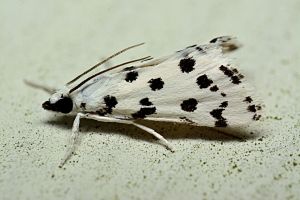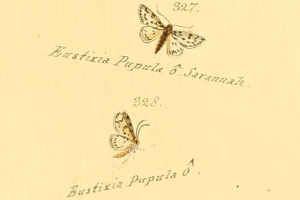

 +2Kontinente:EUNA
+2Kontinente:EUNA1. Lebendfotos
1.1. Falter
2. Diagnose
2.1. Erstbeschreibung
3. Biologie
3.1. Nahrung der Raupe
- [Brassicaceae:] Lepidium virginicum (Virginische Kresse)
- [Brassicaceae:] Brassica oleracea (Kohl)
- [Brassicaceae:] Thlaspi arvense ? (Acker-Hellerkraut ?)
Laut Internetquellen soll die Raupe an Lepidium und Thlaspi arvense (Brassicaceae) leben. Lopez-Vaamonde et al. (2010: 651) nannten Lepidium virginicum und "cabbage". Munroe (1972: 145) hatte schon früher zusammengestellt: "The larva has been described by Dyar ( 1900: 155) and notes on its occurrence and distribution were given by Shapiro (1968: 157). Dyar's description was overlooked by Forbes (1923) as well as by myself (Munroe, 1961) and by Shapiro. The larva feeds on peppergrass, Lepidium virginicum L., feeding in a delicate web on the heads, eating unripe seeds out of the flat pods and leaving two holes in the upper surface of each pod. According to Shapiro it is also a leaf-feeder and occurs on cabbage, Brassica oleracea L. cultivars, and on Brassica nigra (L.) Koch, as well as on peppergrass. On cabbage it occurs on the undersides of leaves on the outer part of the head. The last stage is green. The ocelli are black and the head is mottled with brown. The subventral fold is narrowly whitish. There are dorsal segmental bands of a dull crimson color reaching the subventral fold laterally; the edges of these bands are irregular and project anteriorly at the spiracle. The setae are fine, dusky and rather long."
(Autor: Erwin Rennwald)
4. Weitere Informationen
4.1. Faunistik
Die Art wurde aus den USA beschrieben und ist in deren Osthälfte weit verbreitet. Bei heißt es: "The species ranges from southern Ontario to Massachusetts, Florida, Wyoming, Missouri and Brownsville, Texas. In the vicinity of Philadelphia it is double-brooded, with adults flying in May and early June and again in late July and early August." Neuere Daten zur Verbreitung in den USA gibt es z.B. auf den Seiten der [mothphotographersgroup.msstate.edu], der [butterfliesandmoths.org] oder der [massmoths.org].
Lopez-Vaamonde et al. (2010: 651) nahmen sie für Großbritannien in ihre Liste der nach Europa verschleppten Arten auf und beriefen sich dabei auf Budd & Goater (1998). Da ich jenen Aufsatz noch nicht gelesen habe, sind mir nicht alle Details dazu bekannt. Agassiz et al. (2013: 112) jedenfalls führen die Art bei den "adventive species" und schreiben zu England: "One Southampton, Hampshire, 1997. American."
(Autor: Erwin Rennwald)
4.2. Literatur
- Agassiz, D.J.L., Beavan, S.D. & R.J. Heckford (2013): Checklist of the Lepidoptera of the British Isles. - Royal Entomological Society. 206pp.
- Budd, P.A & B. Goater (1998): Eustixia pupula Hübner, 1823 (Lepidoptera: Pyralidae, Odontiinae), a New World pyralid new to Britain and Europe. — Entomologist’s Gazette, 49: 169–170. [Sekundärzitat]
- Erstbeschreibung: Hübner, J. (1823): Zuträge zur Sammlung exotischer Schmettlinge [sic], bestehend in Bekundigung einzelner Fliegmuster neuer oder rarer nichteuropäischer Gattungen. Zweytes Hundert: 1-32, 8 unpaginierte Seiten, pl. [36]-[69].
- Lopez-Vaamonde, C., Agassiz, D., Augustin, S., de Prins, J., de Prins, W., Gomboc, S., Ivinskis, P., Karsholt, O., Koutroumpas, A., Koutroumpa, F., Laštůvka, Z., Marabuto, E., Olivella, E., Przybylowicz, L., Roques, A., Ryrholm, N., Šefrová, H., Šima, P., Sims, I., Sinev, S., Skulev, B., Tomov, R., Zilli, A. & D. Lees (2010): Lepidoptera. Chapter 11. In: Roques, A. et al. [eds.] (2010): Alien terrestrial arthropods of Europe. — BioRisk, 4(2): 603–668. doi: 10.3897/biorisk.4.50. [zur Arbeit auf biorisk.pensoft.net]
- Munroe, E. (1972): The Moths of America North of Mexico. Fasc. 13.1B. Pyraloidea. Pyralidae. Comprising subfamilies Odontiinae - Glaphyrinae. - 78 S. + plate A-H; London. [PDF auf peabody.yale.edu]






